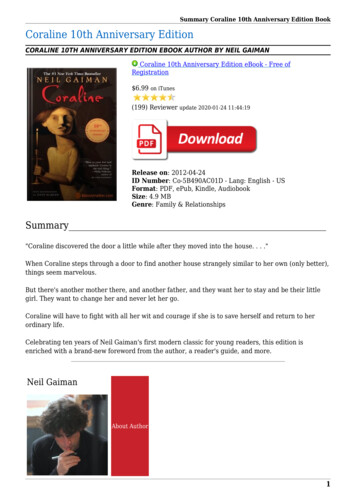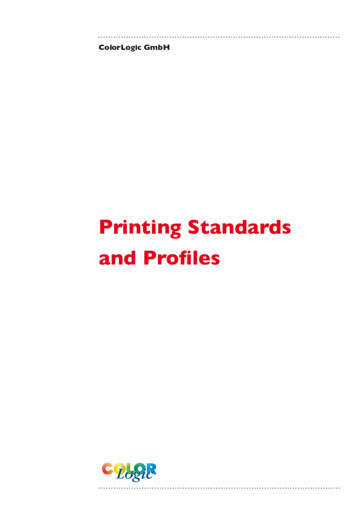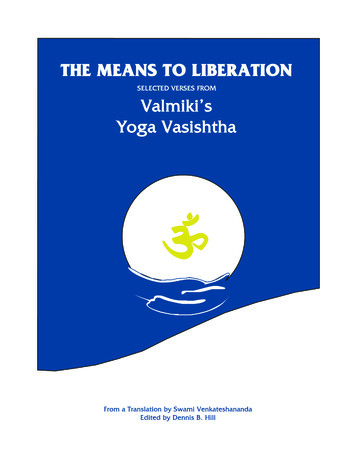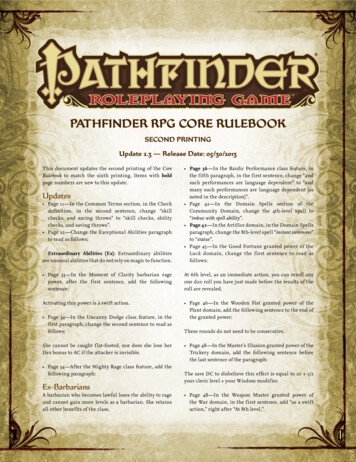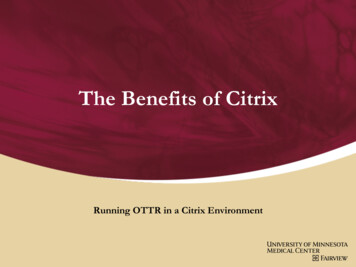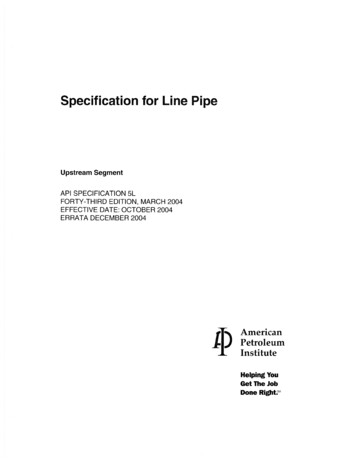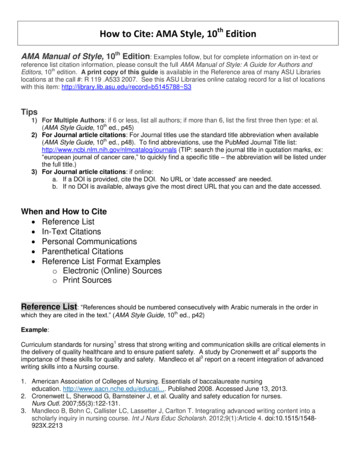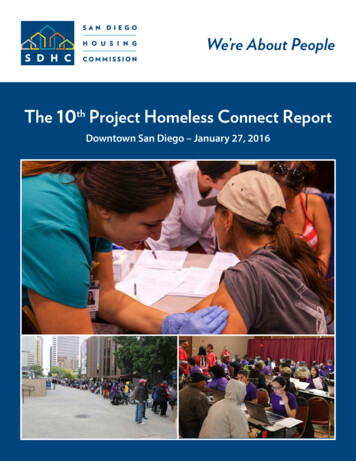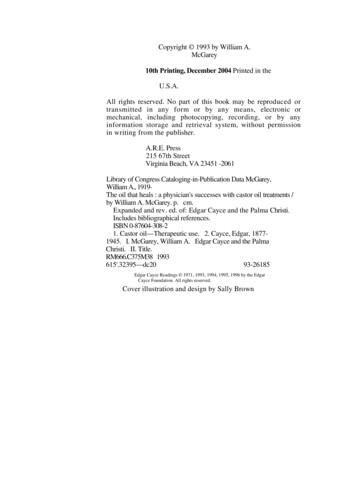
Transcription
Copyright 1993 by William A.McGarey10th Printing, December 2004 Printed in theU.S.A.All rights reserved. No part of this book may be reproduced ortransmitted in any form or by any means, electronic ormechanical, including photocopying, recording, or by anyinformation storage and retrieval system, without permissionin writing from the publisher.A.R.E. Press215 67th StreetVirginia Beach, VA 23451 -2061Library of Congress Cataloging-in-Publication Data McGarey,William A., 1919The oil that heals : a physician's successes with castor oil treatments /by William A. McGarey. p. cm.Expanded and rev. ed. of: Edgar Cayce and the Palma Christi.Includes bibliographical references.ISBN 0-87604-308-21. Castor oil—Therapeutic use. 2. Cayce, Edgar, 18771945. I. McGarey, William A. Edgar Cayce and the PalmaChristi. II. Title.RM666.C375M38 1993615'.32395—dc2093-26185Edgar Cayce Readings 1971, 1993, 1994, 1995, 1996 by the EdgarCayce Foundation. All rights reserved.Cover illustration and design by Sally Brown
DEDICATIONThis book is simply, but with a great deal of love, dedicated to two individuals who have together shaped worldthought in a way that benefits every individual living in it.Edgar Cayce was born in 1877 in Hopkinsville, Kentucky,and lived a life that was sometimes painfully eventful. Hehad developed a gift in former lifetimes, however, whichgave him the capacity to lie down and enter a state of altered consciousness that could then be tapped. He was ableto touch in on the akashic records and the information inwhat we call universal consciousness.He could contact the unconscious mind of individualsfar distant from where he was giving a reading and coulddescribe not only past lives, but also the state of theinquirer's physiological functioning and what needed to bedone to return that individual to full health.His legacy for the world was a library full of nearly 15,000psychic readings of such depth that they have not beenequalled in this century, if, indeed, in any century. Hundreds of books have been written about this man and hisreadings, and thousands upon thousands of men andwomen and particularly children have awakened to new lifethrough the use of the information he left I have not seensuch a legacy rivaled in the thirty-seven years I have spentworking with psychic data and this material as it related tothe practice of medicine.Edgar Cayce called his work the work of the Christ, andanyone who studies these readings to any depth wouldmost likely agree. I certainly find it to be so.I could not stop there. For, without the lifetime that HughLynn Cayce (Edgar's eldest son) spent working with thereadings, bringing the Work of the Christ to the attention ofthe world through his leadership, his traveling, speaking,writing, and enthusiasm, the A.R.E. would probably not
ForewordThere is no zealot like the nonbeliever whohas seen thelight. I suppose I fit that description when it comes to castoroil. As a child, I had too many distasteful encounters with aconcoction my mother made by adding a liberal dose ofcastor oil to my orange juice and making sure that I forced itdown. I hated the taste, and for years afterward avoided orange juice because of the unpleasant association.Today, thanks to having been enlightened by Dr. WilliamA. McGarey, I'm a true believer that we can enjoy the healthbenefits of "the oil that heals" without drinking a drop of it.Consequently, I keep a bottle of it close at hand and use itoften. Castor oil often seems miraculous, for who wouldexpect so many beneficial medicinal effects—everythingfrom preventing abdominal surgery to dissolving gallstonesand eliminating warts—from a common, inexpensive lubricant, used mostly today for industrial purposes.In describing cases of magical recoveries by his patientsIX
who applied castor oil, Dr. Bill reminds me of a New England doctor who years ago proclaimed the health benefitsof drinking water laced with honey and vinegar. It is sosimple and inexpensive, one wonders why all doctors don'trecommend itBut Dr. Bill does much more here than tell poignant success stories of sick people who got well by applying the oilhe often recommends. He offers us a basic education aboutthe healing process itself—a process misunderstood bythose who believe that it is the doctor or the drug, or both,that heals us. Not so, says the author, based on his long experience as a family physician. Healing is a naturalGod-given function of the body, in collaboration with themind and spirit. Disease or a failure to heal signals a dysfunction in one or all systems.Dr. McGarey, a true medical pioneer, has shown greatcourage in betting his professional reputation on this concept, which he learned from studying and testing theconcepts found in the Edgar Cayce readings, because it isvery disturbing to many elements of the health care community. Many mainstream practitioners scoff at this"unscientific" theory—although it is one that is much morewidely accepted today than when Dr. McGarey began practicing it over twenty years ago at the A.R.E. Clinic hefounded in Phoenix, Arizona. Many patients reject this concept of healing because they would rather believe they arethe victim of an external cause than take personal responsibility for their condition. And the "disease-care industry," asDr. C. Norman Shealy describes the hospital-health insurance business, finds this concept threatening. It couldreduce health problems if we learn to give our body-mindspirit all the natural advantages needed to promoteself-healing. Dr. Bill is doing his very best to teach us how.While some health practitioners may regard "the oil thatheals" as just another "snake oil" or placebo, readers will
learn that Dr. McGarey*s clinical research has demonstratedthat the application of castor oil externally to the abdomencan increase significantly the total lymphocyte count, thusstrengthening the body's immune system. The results of thispreliminary testing at the A.R.E. Clinic, financed by a grantfrom the Fetzer Foundation, should be enough to justifymuch greater research into the healing mechanism triggered by castor oil.Meanwhile, Dr. Bill continues to do what he feels calledto do, a humble healer with a noble mission that is servedwell by this valuable book. It is a worthy addition to any library, as a primer for understanding the growing awarenessof "energy medicine" and as a handy reference for when touse the oil for many minor ailments and serious dysfunctions. For as a country doctor he quotes once said, "Castoroil will leave the body in better condition than it found it."That's a sound prescription for us all.A. Robert SmithEditorVenture Inward magazineXI
IntroductionTHERE REALLY ISN'T A MIRACLE CURE FORANYTHING, for miracles are just amazing happenings thatcome about from application of truths lodged somewherein the realm of the yet-unexplained laws of the universe.However, it seems like a Tiiracle when someone gently rubsa bit of castor oil over and over on a skin cancer of the ear,for instance, and the cancer just gradually disappears. Itmight take days or weeks or a few months, but it just doesn'tmake good sense. For who would attribute miraculouspowers to a substance as lowly as castor oil? Yet this has happened, and the owner of the lesion on the ear feels as if heor she has discovered a new world. It's really a miracle tothat individual.This book is not about miracles, but it certainly has itsfoundation in the kind of healing that takes place when castor oil is used on—and sometimes in—the human body.Castor oil has a specific kind of an effect which some haveMil
called vibratory, when it is used therapeutically. For thepresent time, however, it probably is proper to say that themethod of healing by using this oil is still undetermined.The results, however, have been apparent—not only in myexperience, but in ancient times, as well as earlier in thiscentury as reported in the medical literature.It was twenty-six years ago that I first wrote a book aboutthe use of castor oil in the practice of medicine. At that time,the manuscript was intended to be a simple report on theuse of castor oil packs in the healing process of the humanbeing. It was a monograph.However, after the first couple of years, it became obvious that the book would be helpful for the lay reader insearching out ways of improving one's health and generalwelfare, in addition to alleviating the symptoms of an illness. So the monograph became a book. And it came to becalled Edgar Cayce and the Palma Christi.Now, after forty-six years in the practice of medicine andmore than thirty-eight years as a student who has put intopractice the concepts found in the Edgar Cayce readings,and after thousands of copies of the Palma Christi havefound their way into the hands of the general public, I feel itis important to update and add to the original manuscriptI am including some of the more important lessons I'velearned and some of the interesting happenings that havecome my way as my patients, my family, and my friendshave used the castor oil packs on their own bodies.Also, as these years have passed by, I've found the Bibleand its contents coming into close association with the human being and a person's amazing capabilities to becomehealed, and I've found the mind (the conscious and the subconscious) to be the link among the body, the emotions,and the spiritual essence of what we really are. The Biblewith its wisdom, the Edgar Cayce readings, the mind, andthe body are all interrelated through the use of these amazXIV
ing castor oil packs, as you'll see as you follow my adventures through the pages of this book. It has truly been anamazing journey for me through this environment we callthe earth plane.My most vivid memory of one part of the Bible—the 23rdPsalm—has me standing with my portable tape recorder inthe very center of the Greek theater located just a stone'sthrow from the spot where Aesculapius is said to have hadhis temple of sleeping and dreaming; where legend saysthat those who suffered with a diversity of illnesses came,slept, dreamed, and—in their sleep and dreaming—theywere healed. I was standing there, surrounded by the ghostsof memories, listening to and recording the voice of HughLynn Cayce, the son of Edgar Cayce, as he stood in the highest row of seats in this acoustically near-perfect theater,whispering the words of his favorite psalm.The latter portion seems especially significant here:"Thou preparest a table before me in the presence of mineenemies: thou anointest my head with oil; my cup runnethover. Surely goodness and mercy shall follow me all the daysof my life: and I will dwell in the house of the Lord for ever."(v. 5-6) Jesus was called the Christ, the Anointed One, forthe Christ means "anointed." The mind of humanitythrough the centuries, apparently, has known that oil is necessary for anointing, though one cannot easily say why. Onetype of union with God, certainly, is symbolized by theanointing with oil. Is this perhaps a healing of another portion of ourselves?To my mind, this is not unlikely for my experience hastaught me that the greatest mystery in the universe is notouter space; it is not what might be found in the depths ofthe earth; but rather it is in the innermost parts of the human being, you or me, the entity, the soul that God createdin the beginning and made in His image as a spiritual being.xv
These three seemingly diverse subjects—Aesculapius,the 23rd Psalm, and my chosen life profession—all appearto be related: dreaming is not only for the health of themind, anointing is not only of the spirit, and healing is certainly not only of the physical body.Perhaps it was, in part, this background which led me tobegin investigation into the use of an oil which has its origins in antiquity; which, in turn, has almost been discardedby medical practice today; but which, in his psychic discourses for those who were ill, Edgar Cayce advocated formore than fifty different conditions of illness in the humanbody and to which he attributed some quite remarkablequalities.Castor oil is still used in medicine as a cathartic, but myuse of it in the form of a pack came about because of myfamiliarity with the Cayce readings, because of my study ofthem, and because I saw literally hundreds of instances inwhich such packs were advised for conditions of the bodythat seemed to be—in most instances—unrelated to eachother. Yet each person was advised to use the same therapy.It would be difficult to state now for what kind of condition I first recommended the use of the castor oil pack. Asresults came, however, its utilization became more andmore frequent. After three or four years, I began my earlierreport, which eventually became the book dealing with myexperiences up to that time.In the years that have passed since that first attempt torecord the changes that occur within the physiologicalfunctioning of the body from the use of castor oil, literallythousands of individuals have benefited by castor oil applied as a pack and as a substance to be rubbed onto thebody. There is probably no portion of the external humananatomy that has not been treated with this remarkablesubstance.Then why not call it "the oil that heals"?XVI
PartiChapter OneDon't Forget to Smellthe DandelionsWHEN I WAS A FIVE-YEAR-OLD BOY playing onthe hills that rimmed the Ohio valley, I discovered a magnificent flower. It had a wonderful yellow-orange face to it,which magically changed after a few weeks to a fluffy whiteball of what my parents called seeds. To me, they were oneof nature's miracles—I could pick one of those longstemmed objects of wonderment, hold it close to my mouthand gently blow, and off they would go, these little whitefloaters, into the wind to land far away from my sight.But the flower itself carried even more interest for me. Iused to lie down on the grass and smell the dandelion as itwas clothed in all its glory. I wondered about that bit of nature. My nose told me there was not much of an odor, butan aroma of some sort did seem to be there. And I wondered, "What can the dandelion be good for?"In my later years, it occurred to me that perhaps memories of a past life as a doctor using herbs could have been
2/THE OIL THAT HEALSstirred deep within me, to give me that early interest in thedandelion. Most people think it is simply a weed, especiallywhen it gets a good start on one's lawn.But that memory of lying there on the grass, not far frommy home, smelling the dandelion has made its place in mylife ever since. It symbolized for me the inquisitive spirit thatmust be in all individuals, if they are to understand theirorigin, their destiny, and the nature of all those mysteriesthat are locked within every created object that becomespart of our personal experience.The dandelion (Taraxacum officinale), as a matter of fact,is a highly respected herb, nutritious in its nature and usedto clear obstructions from and to stimulate the liver todetoxify poisons in the system. It has a strong alkalinizingeffect to neutralize acids and acts as an eliminatory herb inmaintaining body health and as a building agent The leave?and the root are the active ingredients most commonlyused, and dandelion tea is applied most frequently in renal,bladder, and liver difficulties.1Perhaps the flower is there to catch one's attention andthrill all those who are, by nature, inquisitive and investigative. But there is a value, too, and I've found that most ofnature—given us through the kindness of Goo!—is here tobe used for aid and for help, once its use is determined.The experience with the dandelion has proved to me thatthe commonplace things one tends to neglect in travelsthrough the earth are often uncommon in their true value,so let's always remember—even when we are grown andrelatively sophisticated—to smell the dandelions.It was not long after that that my mother died followingsurgeryforpulmonary tuberculosis. I was seven, andl—likemy two brothers—cried when I found out that mother hadleft us and would not be seen again. Some years later, whenthe idea of reincarnation became part of my belief system, Iunderstood death as a passage from one room to another,
DON'T FORGET TO SMELL THE DANDELIONS/3from one environment which we call the earth plane to aspiritual setting where the surroundings are of a differentvibratory nature. When we make that change, it is really I oryou who steps into that other dimension.When my mother died, I wasn't wise enough to smell thedandelions in that experience. Looking back, however, Iknow there is truth in the concept that every experience isan opportunity for soul growth. If life is indeed continuous,my inner being must have been aware of that reality, andwhat Edgar Cayce had to say about it was my inner lesson:Life is continuous! The soul moves on, gaining byeach experience that necessary for its comprehendingof its kinship and relationship to Divine. (1004-2)My belief system was rooted early in the Presbyterianchurch, although I have had past incarnations, too, as aCatholic priest. But in this life, I chose parents who hadadopted the Presbyterian approach to their understandingof the Divine. From the time I was twelve years old, I taughtothers about the biblical story. At first, I taught seven- andeight-year-old students. After many years, I taught adults.In between, I aimed my life toward the ministry, butchanged it midstream to medical education.But my faith included the view of a Creative Force in theuniverse—and even outside the universe—which broughtme into being and which created all things. This viewbrought me later to the writings of the Chinese mystic, LaoTsu. He found the Divine to be the Mother of the Ten Thousand Things, and just as much of a mystery. These fewwords, however, from the Too Te Ching2 helped me feelmore in touch with that which I could not truly explain:Something, in veiled creation, came to beBefore the earth was formed, or heaven.
4/THE OIL THAT HEALSIn the silence, apart, alone,It changes not, is ever present, never failing—Think of it as the Mother of the Ten Thousand Things.It seems to me now that we need a basis from which tostart understanding the mystery of the body and that whichbrought it into being. I didn't look at life in exactly that wayduring my formative years, but what was happening insidemy unconscious mind was the adoption of the idea of Godas the Creative Force, the Beginning of all things, the Wisdom that created me with His potential and made the pathclear for the return voyage. And I accepted Jesus as theChrist, the Anointed One, who had already made the tripback to His beginning and who had performed somethingmystical here in the Earth that is still difficult to understand.Another experience for me, another step.Communication has always been important to me. When Iwas in the eighth grade, my teacher told me I would someday write a book—she apparently saw that in my writing.From the time I was eleven years old until I finished college,I worked in some capacity with newspapers. Paperboy,printer's devil (they had those in the '30s), reporter, typesetter, printer, and—for a period of several months when theeditor of the small-town newspaper was down with a heartattack—I was the acting editor of the paper—at age eighteen.In college I took part in writing, helping to create a literary publication, writing poetry and short stories, andhelping with the college newspaper, editing it in my finalyear. It seemed that writing was something that had to bepart of my destiny, wherever I found myself. The experiences that came about during those years taught me how tocommunicate, but one cannot communicate unilaterally.To write a story for the newspaper, I had to ask questionsand listen to those who knew what was happening. ThenI put my talents to work.
DON'T FORGET TO SMELL THE DANDELIONS/5It must be that way, to some extent, as we work with ourphysical body. If we pay no attention to what our body istelling us, we may end up with a perforated ulcer of thestomach instead of the earlier overacidity. Listening will tellus that something is wrong, something is burning in ourstomach. Why not listen and give the communication a response—change our diet, our life style a bit, and introducesome antacid preparation?One of the most frequent criticisms I hear about today'sphysicians is that they don't listen. Patients tell me this, theirvoices ringing with resentment and anger, for they all believe they know something about their own body. It is, afterall, their body. They know how they feel. And to them, howthey feel is important. If their doctor won't listen, frustration results and there is further disruption of the physicalbody because of the emotional upheaval.Communication is always a two-way street. Knowledgeof our body requires a sensitivity to what is going on and aresponse to that need. It doesn't always take a doctor toknow when something is happening inside, and then whatour conscious response brings about in the way of correction.Sometimes, like a rumor that a reporter catches on thefly, there is a hint of something going wrong inside the bodythat comes in an instructive dream. Both the rumor and thedream need investigation. Once investigated and interpreted, the rumor may become fact that can be publishedin the paper and the dream may become a therapy that canbe instituted in the body. The key is to listen, appraise, thenact.
Chapter TwoMedical School andEarly Practice YearsEXPERTS ABOUND IN ALL MEDICAL SCHOOLS,AND MY classmates saw them as the fountainhead of allknowledge—gurus, in a sense. Much knowledge, but littlephilosophy. Philosophers are rare indeed in medical hallsof learning. They are present, but their voices are outnumbered, unheard, or discounted. Existence of a Higher Power,a Creative Energy, a God, was not acknowledged in my fouryears of medical schooling. Except, perhaps, in the form ofprofanity.I recall clearly a particularly wild argument I had withJohn Miley, one of my classmates. He was saying, "That'swhat the experts say in the textbooks." I was telling him whytheir statements did not make sense to me, and questioning why I should accept their point of view. Commonsense—philosophy—does not often find its way into medical literature.Early in my practice of medicine, a pathologist was look-
MEDICAL SCHOOL AND EARLY PRACTICE YEARS/7ing at a section of the appendix which had been removed.He told me it showed appendicitis. I looked at the specimen and asked the doctor how many lymphocytes had tobe there to designate it as appendicitis instead of a normalappendix. He shrugged off the question, but I persisted because normally the appendix does have lymphocytespresent when nothing is wrong. Such a presence is, in fact,a part of the immune system, which encompasses all thelymphatic tissue in the body. It appeared to me that thenumber of lymphocytes present simply gave the pathologist an opportunity to make an educated guess. His guesswas "appendicitis." My pathologist was unhappy with me,but he didn't know that I used to smell dandelions.I found out from these two experiences that all things arenot really as they seem. The experts are not always right, aswe often assume, and disease is not an on/off phenomenon, but rather a process found active within thephysiology of the human body.Medical school did teach me, however, about the structure of the body, about physiology, something about thevarious specialties, a great deal about pharmacology, muchabout pathology—the end point of a disease process—butmost significantly we were taught about diseases, how torecognize them when they appear (sometimes as if bymagic), and how to do battle with them. We were not taughtthat the body frequently has amazing abilities to overcomethe beginning stages of a disease process, if given a bit ofhelp here and there. And we were not given any instructionabout nutrition, dietary practices, or the effect of theseupon the health of the body. Nor were emotions and theirdirect effect upon the functioning of the body given credence.I was impressed by the work which Richard VUter, one ofmy professors, had done in the field of vitamins, and I couldnot understand why the use of vitamins as an aid to the
8/THE OIL THAT HEALSbody was not more widespread. I tested vitamins early inmy medical school career, and I found that I had more energy and simply felt better when I used them. Anotherinsight—something good might be happening within thebody tissues when you simply feel better. But argumentsstill rage about what vitamins do and do not accomplish.A good night's sleep will often make one feel better. Seeing someone you love will do the same. A good hug;—or abunch of hugs—will enhance that same feeling. Recentwork has shown that one feels worse when one frowns, feelsbetter if one puts a smile on one's face—no matter how"down" the person may feel prior to the smile. And, if thingsget worse, laugh! That's another way to move toward happier, feeling-better times. To a degree, those happier timesspell healing of the body.It was shortly after I began my practice of medicine in myhome town ofWellsville, Ohio, that I discovered another wayto gain an insight into myself—another way to smell thedandelions. It was a very busy time, and house calls werestill a way of life in that mid-Western town.After an especially busy day including house calls, surgery in the morning, and a full day at the office, I finallyclimbed into bed. When the phone rang shortly after midnight, I groaned. I was summoned on another call, and Igrumbled all the way to my car, vowing to charge five dollars instead of the usual three.When I returned home, more like a pussy cat than theroaring lion, I tried to sneak into bed without waking mywife. But she heard me and said, "Well, did you charge themlike you said you would?" I told her I didn't—that the littlegirl was really sick, and besides, they didn't have any moneyto pay me for the visit. We went to sleep again.It was at that point that I became aware that service waswhat I was there for and I chose it. My later years emphasized that concept of service and enlarged on it, for how is
MEDICAL SCHOOL AND EARLY PRACTICE YEARS/9the quality of Divine Love best manifested, unless it is inhelping those who need help, caring for those who are anxious and insecure, those who are sick in body, mind, orspirit?
Chapter ThreeA Chance Encounter(If Chance Is Yet a Reality)NOTHING REALLY HAPPENS BY CHANCE,DOES IT? AT least that was what I was to find repeated overand over again in the Edgar Cayce readings. I was now inthe practice of medicine in Phoenix, Arizona, having startedover again after a stint in the air force as a flight surgeon.It was 1955, and I had been in town just a few months. Ihad started an exploratory adventure into the field of parapsychology with a friend of mine, Dr. Bill Rogers. We hadcome across a wonderful story about Edgar Cayce—a manwho could lie down on a couch and enter an altered state ofconsciousness—and really tell what was happening insidethe body of another individual who could be 2,000 milesaway. It was as if he were communicating with the unconscious mind of another person, while his own consciousmind was set aside. I was fascinated, but thought—"Well,that's just another event in the past, for Cayce died in1945."10
A CHANCE ENCOUNTERll/Then, one day, my receptionist came rushing into the office and gave me the phone number of a man who wasgoing to talk about Edgar Cayce. It was Cayce's oldest son,Hugh Lynn Cayce, and I was excited.That was the beginning of the adventure that was to takeme through time and space, in a sense, and demand mytime and attention, my thought processes, and my writingand speaking abilities for the rest of my life. For there is stillmuch to be done, some thirty-eightyears after that "chanceencounter." It was Hugh Lynn Cayce who captured myimagination that day after I made the phone call. And theworld was a different place from that point onward.Hugh Lynn told about his father's abilities that night at alecture, and I began to understand how this psychic information could relate to the practice of medicine. Much ofEdgar Cayce's life was spent in giving 14,306 "readings," asthey came to be called. Over a period of forty years, twothirds of these readings—9,604—were given for individualswho were ill; some seriously so. The remainder were for avariety of other reasons. The bulk of his work, then, had todo with what I've been trained in and involved with for mostof my life—the care of those who are ill.The full story of his life is well told by Thomas Sugrue inhis book There Is a River,3 which is biographical in nature.Later on, Jess Steam authored a best seller about Cayce, TheSleeping Prophet,* which emphasizes more the importanceof Cayce's physical readings. Since then, literally hundredsof books have been published about this man or his work,which he stated was the work of the Christ.Cayce died in 1945, but while he lived he was able to liedown on a couch or bed, loosen his tie and collar, and placehis folded hands on his forehead. After a few moments, hewould bring his hands down over his solar plexus, and enter a state that resembled trance or self-hypnosis. It has beencalled in recent years an altered state of consciousness.
12/THE OIL THAT HEALSIn this state, he was able, upon suggestion by the conductor of the reading, to visualize, describe, and commentupon another individual who might be thousands of milesdistant at that moment and a complete stranger to Cayceand those surrounding him. He was able to describe physical conditions which were present in that person's body, inthe bloodstream, the nervous system, or other parts of theperson's physiology; and then give suggestions, which, iffollowed, tended to restore that body back to a more normal condition of health. Each time Cayc
Expanded and rev. ed. of: Edgar Cayce and the Palma Christi. Includes bibliographical references. ISBN 0-87604-308-2 1. Castor oil—Therapeutic use. 2. Cayce, Edgar, 1877- 1945. I. McGarey, William A. Edgar Cayce and the Palma Christ
